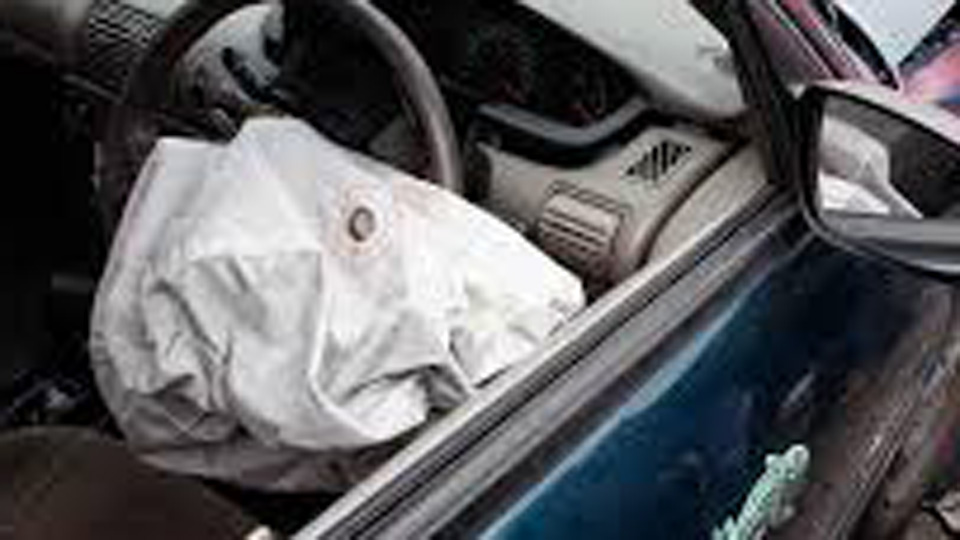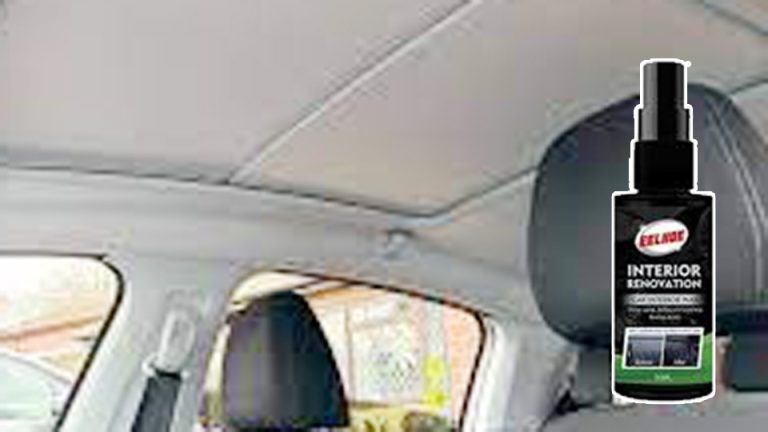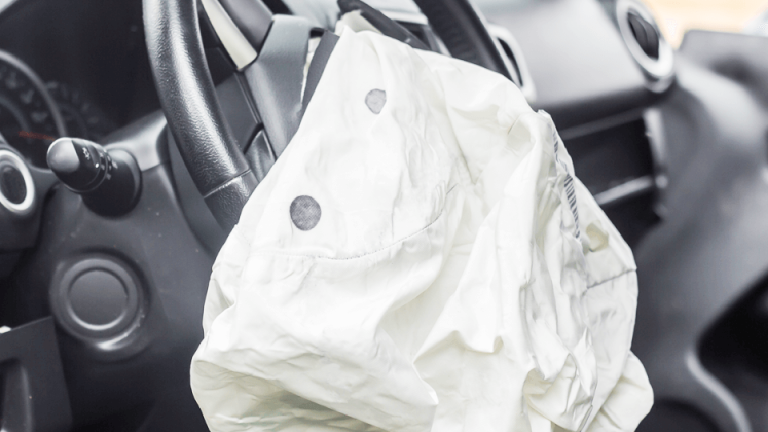If you’ve ever wondered how hard do airbags hit during a crash, you’re not alone—it’s a question that pops up for anyone curious about car safety. As a gearhead who’s spent years tinkering with my Dodge Ram and helping friends with their Hondas and Chevys, I’ve dug deep into how airbags work and what it feels like when they deploy.
Airbags are lifesavers, but their explosive force can feel like a punch, and understanding their impact is key for car owners, DIY mechanics, and everyday drivers across the USA. Let’s break down the science, the sensation, and how to stay safe with airbags, whether you’re cruising snowy Minnesota roads or sunny California highways.

Image by chiropractorconyers
How Airbags Work
Airbags are part of your car’s Supplemental Restraint System (SRS), designed to cushion you during a crash. When sensors detect a sudden deceleration—like hitting another car at 15 mph or more—a control module triggers an inflator. This chemical reaction fills the airbag with nitrogen gas in about 30–50 milliseconds, faster than you can blink. The bag bursts out of its housing (steering wheel, dashboard, or side panels) and inflates to protect you from hitting hard surfaces.
Once deployed, the airbag deflates almost instantly through vents, softening the impact. But that rapid deployment creates a forceful hit, which is why people often ask about it. I’ve never been in a crash with an airbag, but I’ve seen deployed ones in salvage yards—those bags look like they pack a wallop.
Why It Matters: Airbags reduce serious injuries by up to 50%, but their force can cause minor injuries if you’re not positioned correctly. Knowing their impact helps you drive safer and maintain the system, especially in varied US conditions where crashes range from urban fender-benders to rural rollovers.
The Force of an Airbag Deployment
So, how hard do airbags hit? The force depends on several factors, but it’s roughly equivalent to a heavyweight boxer’s punch—about 100–200 pounds of force, delivered in a split second. Airbags inflate at speeds up to 200 mph, covering a small area (like your face or chest), which concentrates the impact. The force is measured in terms of pressure (pounds per square inch, or PSI) and varies by airbag type and vehicle.
- Frontal Airbags: These hit the hardest, as they’re designed for high-speed frontal crashes (15–25 mph minimum). They exert about 10–20 PSI on your body.
- Side Airbags: These deploy with less force, around 5–10 PSI, since they protect against side impacts.
- Curtain Airbags: These spread force over a larger area, hitting at 5–15 PSI.
- Knee Airbags: Found in luxury cars, these are gentler, around 5–10 PSI.
Real-World Example: A friend’s Toyota Corolla was in a 20-mph frontal crash. The airbag left him with a bruised nose and a sore chest, but he walked away from what could’ve been a serious injury. The “hit” felt like a hard shove, not a knockout blow.
| Airbag Type | Deployment Speed | Force (PSI) | Common Location |
|---|---|---|---|
| Frontal | 150–200 mph | 10–20 | Steering wheel, dashboard |
| Side | 100–150 mph | 5–10 | Seat, door panel |
| Curtain | 100–150 mph | 5–15 | Roof rails |
| Knee | 100–120 mph | 5–10 | Below dashboard |
Why It Feels Hard: The rapid inflation and small contact area make the impact feel intense, even though it’s brief. Think of it like a quick slap versus a slow push—it’s over fast but leaves an impression.
Factors That Affect Airbag Impact
The force you feel from an airbag depends on several variables. Here’s what I’ve learned from inspecting cars and talking to mechanics.
Your Position in the Seat
Sitting too close to the steering wheel or dashboard increases the force you feel, as you’re hitting the airbag while it’s still inflating at peak speed. The “10-and-2” hand position is outdated—modern advice is “9-and-3” with your seat back, keeping you 10–12 inches from the steering wheel.
My Experience: I adjusted my wife’s CR-V seat after noticing she sat too close. It’s a simple fix that reduces airbag injury risk.
Crash Severity
Higher-speed crashes (30 mph+) trigger faster airbag deployment to match the impact energy. In a low-speed fender-bender, some airbags may not deploy at all, depending on sensor thresholds.
Airbag Design
Newer cars have “smart” airbags that adjust inflation force based on crash severity, occupant size, and seat position. For example, a Ford F-150’s airbags deploy softer for a 120-pound driver than a 200-pound one.
Vehicle Type
Compact cars (like a Honda Civic) have smaller airbags that deploy with less force than those in SUVs or trucks (like a Chevy Silverado), which need more power to protect larger cabins.
Seatbelt Use
Seatbelts work with airbags to spread impact forces. Without a seatbelt, you’ll hit the airbag harder, increasing injury risk. Always buckle up—it’s a no-brainer.
Warning: Never place a child in a front seat with an active airbag. The force can cause serious injury to kids under 13. Use the back seat and check your manual for airbag shut-off options.
Potential Injuries from Airbag Impact
While airbags save lives, their force can cause minor injuries, especially if you’re not positioned correctly. Common issues include:
- Bruises and Abrasions: The airbag’s fabric can scrape your face or arms, leaving red marks or bruises.
- Burns: The hot gas (up to 300°F) can cause minor chemical or thermal burns, especially on exposed skin.
- Sprains or Fractures: Arms, wrists, or noses can break if caught by the deploying airbag.
- Eye Injuries: Glasses or debris can cause corneal scratches or irritation.
Real-World Example: A buddy’s Jeep Cherokee airbag deployed in a minor crash. He got a bruised cheek and a sore wrist but was fine otherwise. Proper seating would’ve minimized the bruising.
Why It Matters: Understanding these risks helps you prepare—adjust your seat, wear your seatbelt, and avoid distractions to stay safe in a crash.
How to Minimize Airbag Impact Risks
You can’t change how hard an airbag hits, but you can reduce its risks. Here’s how I ensure safety in my vehicles and advise others.
Adjust Your Seat Properly
Sit at least 10 inches from the steering wheel. Adjust the seat height so your chest is level with the center of the wheel, not the top. Tilt the seatback slightly for comfort and safety.
Always Wear a Seatbelt
Seatbelts keep you from slamming into the airbag at full force. Ensure the belt lies flat across your chest and hips, not twisted.
Keep Hands at 9-and-3
Place hands at 9 and 3 o’clock on the steering wheel to avoid arm injuries. This also improves steering control, especially on icy US roads.
Avoid Obstructing Airbags
Don’t hang accessories (like phone mounts) over airbag panels or place objects on the dashboard. They can become projectiles during deployment.
Check for Child Safety
Kids under 13 should ride in the back seat. If your car has a passenger airbag shut-off switch (common in trucks), use it for child seats.
| Safety Tip | Why It Works | Cost |
|---|---|---|
| Adjust Seat | Keeps you at safe distance | $0 |
| Wear Seatbelt | Spreads impact force | $0 |
| 9-and-3 Hands | Reduces arm injury risk | $0 |
| Clear Airbag Paths | Prevents projectile injuries | $0 |
| Child in Back Seat | Protects kids from airbag force | $0 |
My Experience: I once saw a dashboard phone mount fly off during a test deployment at a junkyard. It was a reminder to keep airbag zones clear.
Maintaining Your Airbag System
Airbags are low-maintenance but need occasional checks to ensure they’ll deploy correctly. Here’s how I keep my SRS in top shape.
Check the Airbag Warning Light
When you start your car, the SRS light (a seated figure or “AIRBAG”) should flash for 5–10 seconds, then turn off. If it stays on, blinks, or doesn’t light up, there’s a fault—possibly from a past deployment or wiring issue.
Inspect Airbag Covers
Check the steering wheel, dashboard, and side panels for cracks, loose panels, or mismatched textures. These could indicate tampering or prior deployment.
Avoid Water Damage
In humid or snowy areas like Florida or Michigan, water can corrode SRS sensors. Ensure door seals are tight and fix leaks promptly.
Scan for Codes Annually
Use an OBD-II scanner with SRS capability ($50–$150, like BlueDriver) to check for fault codes. A code like “B1000” could mean a sensor or module issue.
Cost: $0–$150 for a scanner; $100–$300 for professional diagnostics.
Warning: Don’t mess with airbag wiring or modules yourself—accidental deployment is dangerous and costly ($1,000–$5,000 per airbag).
Airbag Replacement After Deployment
If an airbag deploys, it’s a one-time-use component that must be replaced. Here’s what I’ve learned from helping friends with post-crash repairs.
Verify OEM Parts
Replacement airbags must be OEM or from reputable brands (e.g., Bosch, Denso). Aftermarket or salvaged airbags may not deploy correctly. Expect $500–$2,000 per airbag.
Reset the SRS Module
The SRS module stores a crash code after deployment, disabling the system until reset. A dealer or specialized shop can reset it for $100–$300.
Replace Sensors
Crash sensors are often one-use and need replacing ($50–$200 each). Ensure all are OEM to match your car’s system.
Professional Installation
Airbag replacement is not DIY-friendly due to safety risks. A certified shop will charge $500–$2,000 for labor, depending on the car.
Real-World Example: A friend’s Honda Accord needed a driver’s airbag replaced after a fender-bender. The total cost was $1,800, but it restored full safety.
| Component | Cost | Why It’s Needed |
|---|---|---|
| Airbag | $500–$2,000 | Replaces deployed bag |
| SRS Module Reset | $100–$300 | Restores system function |
| Sensors | $50–$200 each | Ensures proper deployment |
| Labor | $500–$2,000 | Safe installation |
Airbag Safety in US Driving Conditions
US roads and climates affect airbag systems differently. Here’s how to keep them reliable:
- Snowy Regions (e.g., Wisconsin): Salt and moisture can corrode sensors. Rinse undercarriage after snowy drives and check wiring annually.
- Hot Climates (e.g., Arizona): UV rays can degrade airbag covers. Use a sunshade and park in shade.
- Urban Areas (e.g., New York): Frequent fender-benders increase deployment risk. Inspect used cars carefully for prior airbag use.
- Rural Roads (e.g., Montana): Bumpy roads can loosen SRS connections. Check the airbag light after rough drives.
My Experience: In humid Florida, my buddy’s Chevy Malibu had an SRS fault from corroded sensors. A $200 sensor replacement fixed it, but regular washes could’ve prevented it.
Common Mistakes to Avoid
- Sitting Too Close: Being closer than 10 inches to the airbag increases injury risk. Adjust your seat properly.
- Ignoring the SRS Light: A constant or missing light signals a problem. Don’t drive without fixing it.
- Using Aftermarket Airbags: Cheap replacements may fail. Stick to OEM for safety.
- Placing Kids in Front: Children under 13 can be seriously injured by airbags. Always use the back seat.
- Covering Airbag Panels: Decorations or mounts can become dangerous projectiles. Keep panels clear.
Buying a Used Car with Airbags in Mind
When shopping for a used car, airbag condition is critical. Here’s how I check:
- Test the SRS Light: Ensure it flashes and turns off.
- Inspect Covers: Look for mismatched or tampered panels.
- Scan for Codes: Use an OBD-II scanner to check for deployment or fault codes.
- Check History: Run a Carfax or AutoCheck report ($20–$40) for accident or deployment records.
- Get a Mechanic’s Inspection: A professional check ($100–$200) can spot hidden issues.
Real-World Example: I passed on a used Nissan Altima when the airbag light stayed on and the seller couldn’t provide repair records. Better safe than sorry.
Conclusion
Airbags hit hard—think a quick, firm shove from a heavyweight boxer—but that force is what saves lives in a crash. By understanding how hard airbags hit and why, you can take steps to minimize risks: adjust your seat, wear your seatbelt, and keep the system maintained. For US drivers, where crashes happen on everything from icy interstates to busy city streets, a working airbag system is non-negotiable. Whether you’re a DIYer or just want a safe ride, regular checks and proper positioning will keep you protected when it matters most.
Pro Tip: Add an annual SRS light check to your car maintenance routine. A quick glance at startup can catch issues before they become dangerous.
FAQ
How hard does an airbag hit compared to a punch?
An airbag’s force (100–200 pounds, 10–20 PSI) is like a heavyweight boxer’s punch but spread over a larger area and lasting milliseconds, so it’s less likely to cause serious injury.
Can airbags cause injuries?
Yes, minor injuries like bruises, abrasions, or burns are possible, especially if you’re too close to the airbag or not wearing a seatbelt. Proper positioning reduces risks.
How do I know if my airbags will deploy properly?
Check the SRS light—it should flash briefly at startup and turn off. Scan for fault codes annually and inspect airbag covers for damage or tampering.
Can I drive with the airbag light on?
It’s risky, as the system may not deploy in a crash. Have it diagnosed and fixed by a professional to ensure safety.
How much does it cost to replace a deployed airbag?
Replacement costs $1,000–$5,000 per airbag, including parts, sensors, module reset, and labor. Use OEM parts for reliability.




